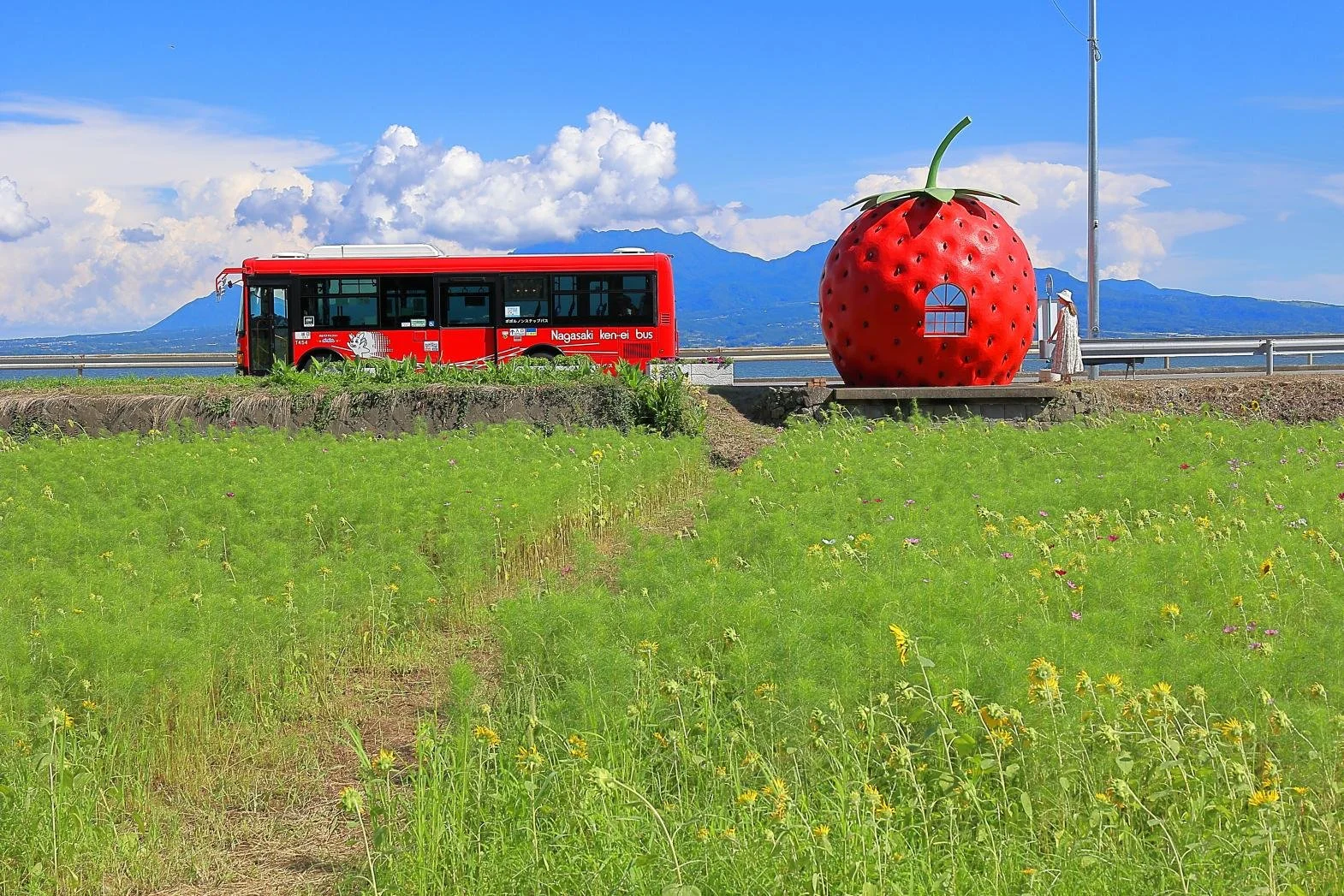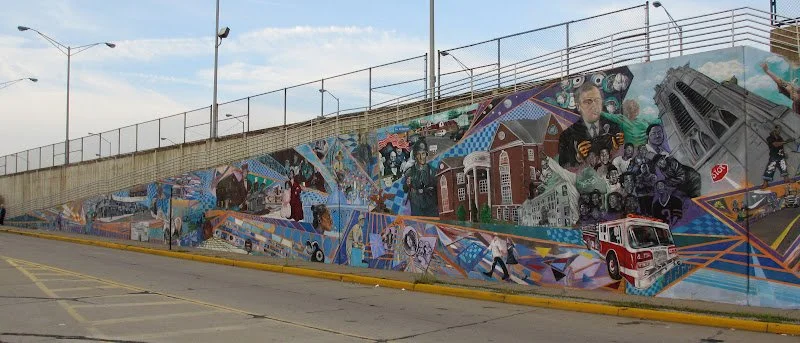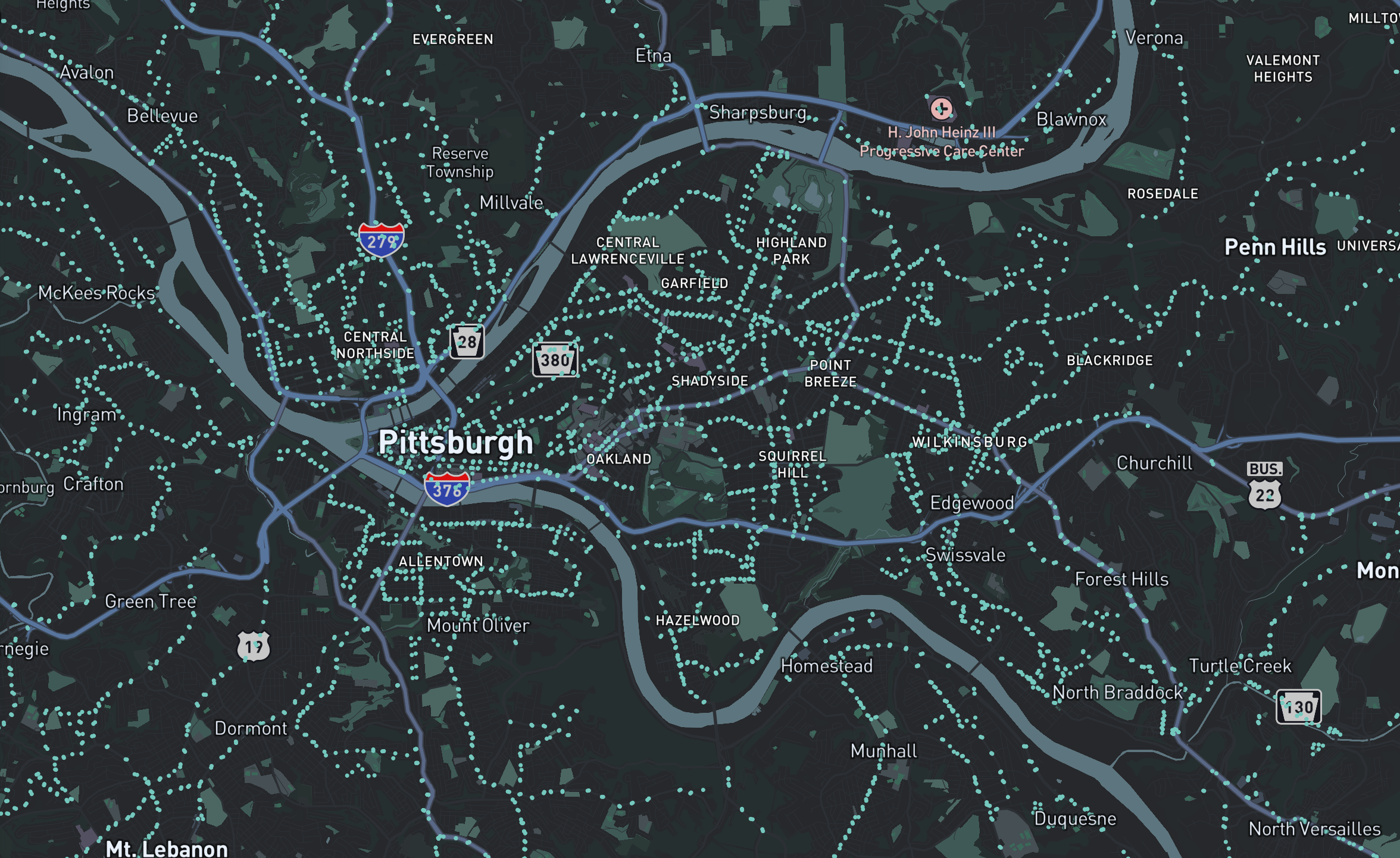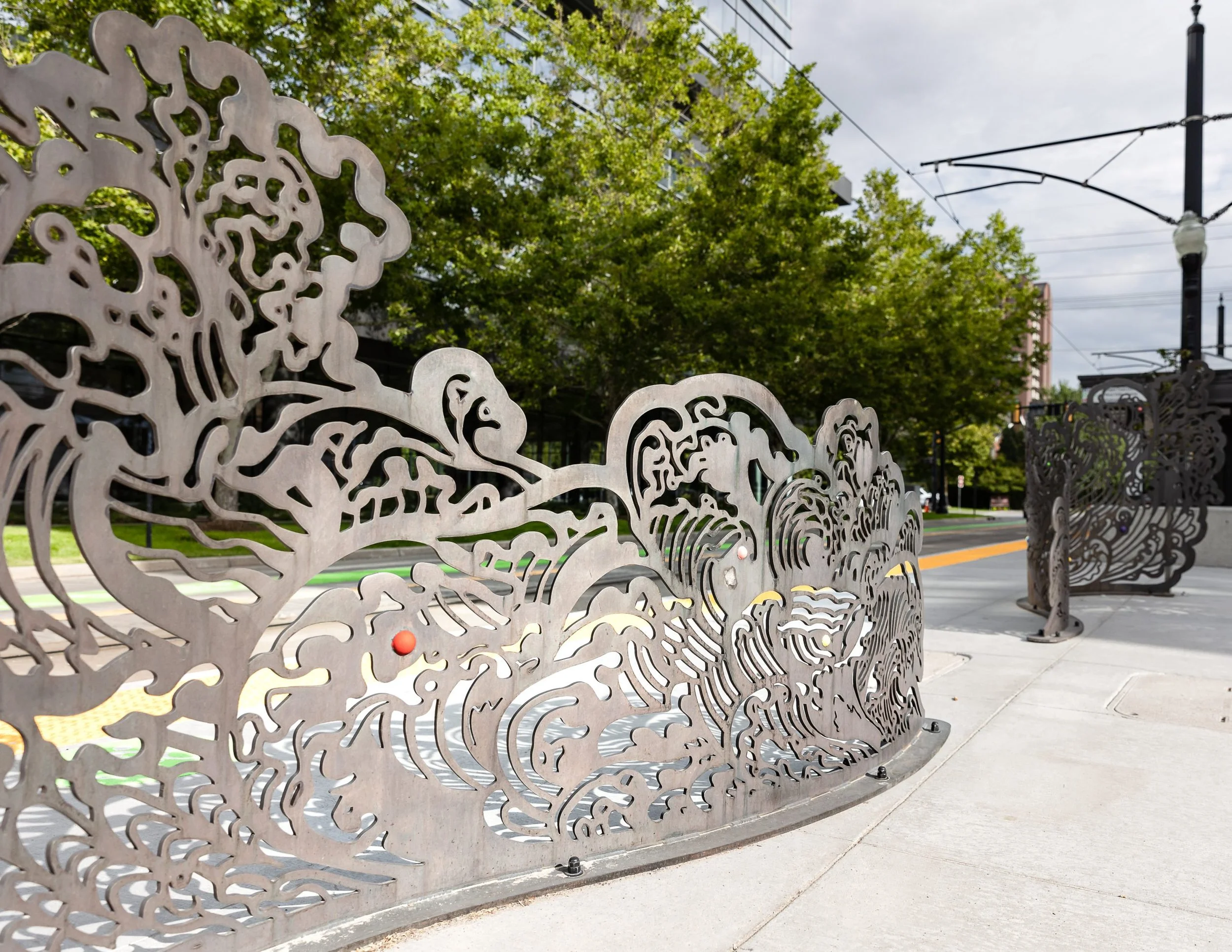When bus stops are transformed from sterile slabs of concrete to works of site-specific art, they become arteries for cultural expression. This success is critical to the growth and overall health of communities, not just in the United States, but around the world. As hubs for people to access their own cities, bus stops can be integral in connecting the communities. Centering transit-oriented communities around established junctions of public art and transportation can be a catalyst for the economic growth and sustainable health of communities.
Image: Mural by Kyle Holbrook depicting the history of Wilkinsburg
Image Source: “Pittsburgh Murals and Public Art: The Story of Wilkinsburg by Kyle Holbrook, Multiple Artists.” Accessed April 7, 2024. https://pghmurals.blogspot.com/2016/01/the-story-of-wilkinsburg-by-kyle.html.
Nestled in the east end of Pittsburgh, Pennsylvania, lies the borough of Wilkinsburg. Once a town bustling with industrial activity, it now faces the challenges that befall areas with declining populations and strained resources, despite harboring a spirit of independence and community. A growing sense of optimism and new development projects hint at the possibility of revitalization of this borough, now plagued by a torn public perception based on crime rates and empty buildings.
However, an emerging call for renewal is preceded by initiatives throughout Eastern Europe and Asia that are marked by a potentially unexpected solution. Public art adorns bus stops in countries across the world, and it is beginning to change the facades of cities in every region of the United States. Public art is a proven tool for improving towns and cities, so it is only a natural step to integrate it into the public transportation that so deeply connects people to place. These artistic interventions go beyond beautification; they encourage strong local identities, deter crime, and promote ridership on public transportation. By examining these programs and their impact on communities, we can gather crucial insights into the potential benefits and challenges of implementing a similar initiative in Wilkinsburg.
Wilkinsburg's potential for revitalization has already been initiated with the "Building on the East Busway" (BotEB) project, a major initiative spearheaded by the Pittsburgh Regional Transit (PRT). This project aims to enhance public transportation along the Martin Luther King, Jr. East Busway, a key artery connecting Wilkinsburg to Pittsburgh and surrounding neighborhoods. The plan includes the creation of new stations, improved pedestrian and bike infrastructure, and the potential for transit-oriented development (TOD).
A successful revitalization effort requires a deeper understanding of Wilkinsburg and the potential for public art in the bus system to initiate positive change. To evaluate the feasibility of this type program, a comprehensive approach was conducted in two phases. First, a critical analysis of the global and American precedents for public art at bus stops draws inspiration from successful programs and their impact on community engagement, crime reduction, and overall revitalization. Next, relevant data was analyzed to evaluate Wilkinsburg's unique needs and ensure alignment with the BotEB project’s vision.
Image: Map of every bus stop in Pittsburgh, Pennsylvania
Image Source: Provided by author
Contrasting Visions: Bus Stops as Art in Japan and the Soviet Union
Transit-centric artwork has, historically, been used as a powerful tool for enhancing urban landscapes worldwide. Bus stops are built for more than just function as they can also act as platforms for artistic expression and reflect local culture and history. From vibrant murals to interactive installations, public art at bus stops engages commuters by transforming mundane waiting times into moments of appreciation. This global trend not only beautifies urban environments but also enriches local identity. Whether showcasing traditional craftsmanship or contemporary concepts, urban transit art serves as a testament to the creativity and diversity of cities across the globe. This research explores the potential of public art at bus stops in Wilkinsburg, Pennsylvania, aiming to revitalize the borough and enhance the rider experience. We can learn valuable lessons from successful public art initiatives at bus stops around the world, starting with one of the vibrant programs implemented in Japan.
In the Nagasaki Prefecture of Japan, Highway 207 is dotted by some of the world’s friendliest bus stops. These seemingly sculptural structures were once a novelty to draw visitors to the Journey Exposition Nagasaki 1990, but gained such popularity that they are now a permanent functional fixture of Isahaya City. The delightful spots of shelter were built to represent the agricultural history, featuring watermelons, strawberries, rockmelons, oranges, and tomatoes, which are all specialties of the Nagasaki Prefecture (Whimsical Fruit-Shaped Bus Stops in Nagasaki 2022). The stops have become an integral part of the residents’ access to public transportation and a spot for tourists to appreciate the history of the area. They are not only part of the landscape, but a monument to it as well.
Image: Bus leaving bus stop shaped like a giant strawberry in Isahaya City, Japan
Image Source: “Fruit-Shaped Bus Stops | See & Do | DISCOVER NAGASAKI/The Official Visitors’ Guide.” Accessed April 7, 2024. https://www.discover-nagasaki.com/en/sightseeing/63101.
While Japan, famed for its deep appreciation for aesthetics in art, film, and tradition, naturally embraced the creation of such inviting bus stops, the push for designing bus stops as civic art surprisingly took hold in a former country known for its more uniform and unadorned architecture. In contrast to the Soviet Union’s more common undecorated buildings, a number of the bus stops were, and continue to be, great works of art. Soviet Era architecture was marked by forms that could be standardized and produced at a low cost, meaning utility was prioritized over aesthetics. Upon first glance, these seemingly decorative bus stops appear to live contrary to these principles. Looking at these stops reveals imagery that promotes the values held by the region that houses them. A Kazakh bus stop houses a mural featuring wheat and machinery to symbolize progress and labor. A stop in Sevan, Armenia proudly displays images of a rich heritage that developed near the sea. Even the stops like one in Balykchy, Kyrgyzstan, while lacking ideologically-focused imagery, express the environment and culture, not dissimilar to the fruit-shaped transit stops in Japan (Herwig, 2015). In a place where cars were uncommon, the bus system became truly celebrated as a space for people to meet each day to share ideas before embarking on their commute.
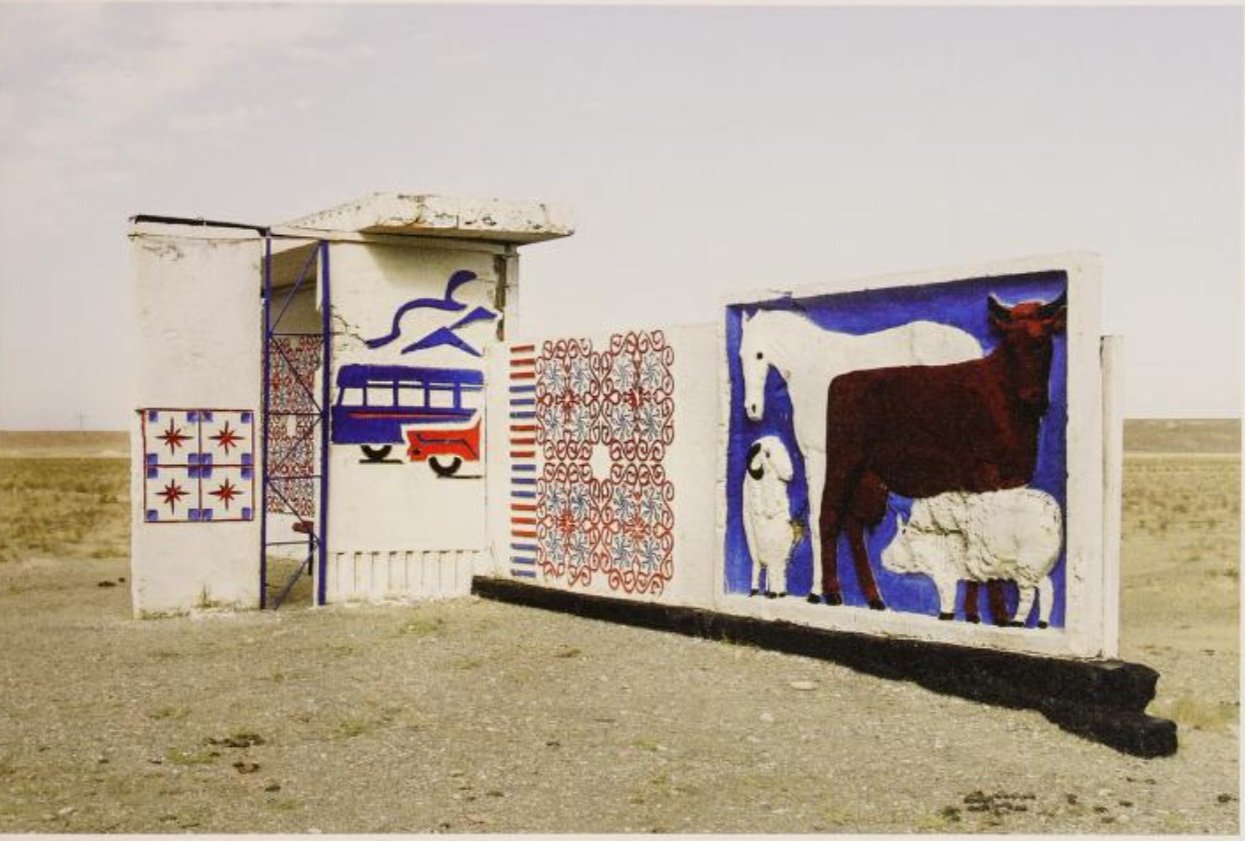
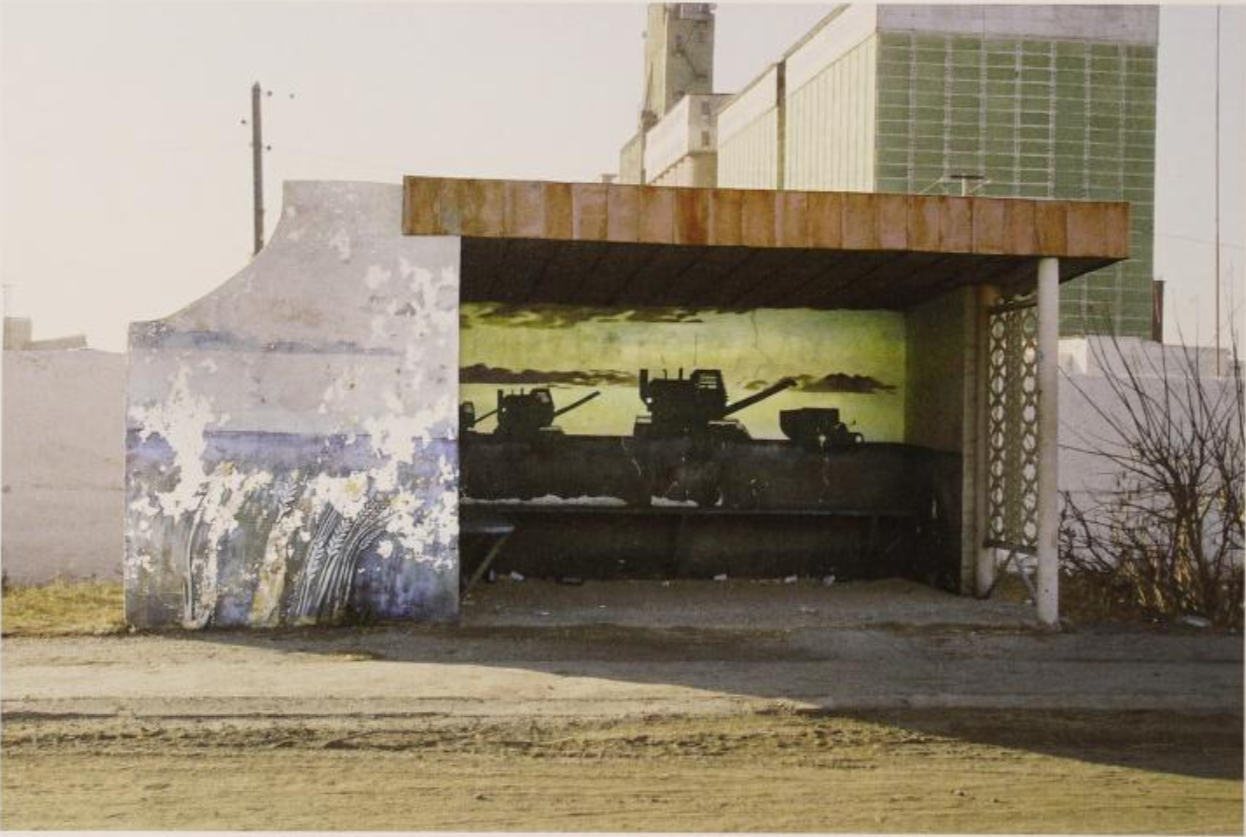
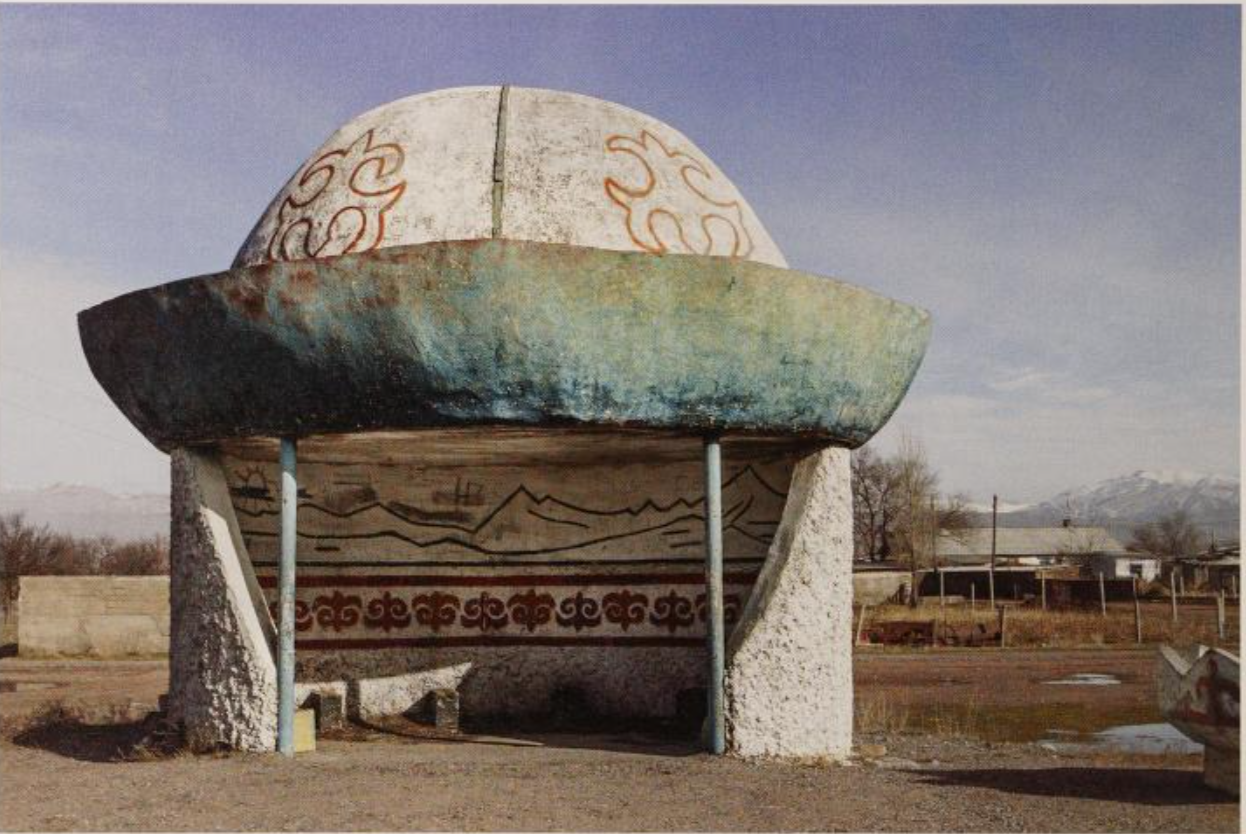

Transforming the American Bus Stop Experience
Having explored a couple of the creative approaches taken abroad, the focus shifts closer to home by examining projects within the United States that can provide insights into public art initiatives at transit hubs that resonate with American communities. Globally, art at bus stops has been utilized to proudly display symbols of culture and values of the past and present while the recent approach of the United States is to incorporate public art to highlight human-centered infrastructure.
In the United States, a trend of Transit Oriented Development (TOD) is being put into practice as human-centered infrastructure begins to take hold of major cities. TOD is an urban planning approach that focuses on creating communities around public transportation hubs with the goal of promoting sustainable, walkable neighborhoods where residents have convenient access to public transportation to reduce the need for cars (Transit Oriented Development 2024). By encouraging people to live and work near transit, TOD can improve mobility, reduce traffic congestion, and promote economic health. While the necessities like shelter, ticketing, and signage should be introduced first, a community needs a connection to the space to hold onto. One of the many tools used for this type of development is public art.
This practice is not limited to the design of bus stops or even murals, as exemplified by Utah. In 2022, Utah Transit Authority and Salt Lake City opened a new TRAX light rail station to bridge three major neighborhoods with Downtown. This effort towards redevelopment supports economic growth and an expansion of Salt Lake’s City core, but they also incorporated a local connection by choosing artist Jiyoun Lee-Lodge to create a sculpture inspired by change in the city for the new station. A stainless steel wave entitled “The Crossing” washes across one of the main walkways to mirror the fluidity and movement of public transportation, its riders, and everyone in the surrounding neighborhoods (Mendenhall 2022). This initiative demonstrates how public art can become a valuable element of community development alongside infrastructure projects by presenting a visual element to connect people to place.
The Crossing, 2022
Jiyoun Lee-Lodge
Stainless Steel
Image: Steel sculpture installation in Salt Lake City, Utah
Image Source:“The Crossing - Salt Lake City Public Art Program.” Accessed April 7, 2024. https://saltlakepublicart.org/art/the-crossing/.
On the other side of the country, the city of Atlanta, Georgia has embraced the concept of infusing public transportation with art and sports. The Metropolitan Atlanta Rapid Transit Authority has partnered with Soccer in the Streets, a local nonprofit, to establish soccer fields at five stations. While the initial goal focused on utilizing a mural designed and painted by artist Kevin Bongang to promote the arts on a soccer field intended for youth development through sports, the result was a space for deeper community building. The mural became a focal point, attracting residents and encouraging them to gather, garden, and socialize (StationSoccer 2020). The results of this widely encompassing initiative suggests that public art can play a much larger role than aesthetics by supporting a sense of community and allowing public spaces to become beacons of social interaction.
In the realm of transportation planning, the integration of arts can provide an incredible option to transform a community by generating participation and advocating for local ownership. These initiatives can take many forms from a focus on public safety for pedestrians to cultivating support for public transportation (Yahner 2015). Several studies, including one published by the RAND Corporation in 2004, indicate that engagement in the arts for at-risk youth yield substantial benefits in regards to significant development of positive communication skills and community involvement by creating avenues for social networking and influence for organizing towards collective action (McCarthy 2004). These skills serve as a protective buffer between youth in areas with high social vulnerability and the justice system. Exposure to the arts has been shown to be useful in forming cognitive processes and prosocial skills among populations considered high-risk for delinquency (Social Vulnerability 2024).
Image: Mural by Kevin Bongang for Soccer in the Streets
Image Source: “MARTA.” Accessed April 7, 2024. https://itsmarta.com/marta-artbound-unveils-mural-at-kensington.aspx.
Participation in the arts can be used as a tool for establishing a positive self image that can bolster the independent identity of individuals and provide them with the mental and emotional fortitude to better themselves with positive activities in their community.
The task for most people coming into an identity is to determine how it will connect to their location. As a consequence, they must respond to the collective identity that a geographic community has established for itself and effectively meet the criteria that the collective has determined best represents them and the space they occupy. The perception an outsider may hold about an area, be it positive or negative, is influenced by their perspective of an area and its people. The art an area uses as a descriptor can be a powerful tool in shaping perceptions, intentions, and potential stereotypes one may hold about a community and gives this community a chance to create its own intentional identity.
Traveling north of Georgia to Philadelphia, Pennsylvania will lead into one of the country’s most notable examples of using public art to define a city’s visual identity. Mural Arts Philadelphia has become an authority on utilizing public art to redefine their city. Their work demonstrates that involving community members in the creation of murals provides residents with agency and physically ingrains a sense of self in the foundation of their neighborhoods. Arts-based programming is available in every facet of America’s public safety sector as studies suggest the presence of cultural amenities has a correlation with improved economic health and increases in population (Ross 2016).
The Data on Driving (or not!)
Public art can often be a small part of the solutions involved in eliminating barriers to supporting TOD. While there are many elements of development that must be achieved before public art planning can be implemented, walkability is one of the most crucial to consider. As 69% of public transportation users walk to their bus stop and 76% walk to their destination after departing from the bus, the journey to integrating bus stops into the community begins with one of the most basic modes of transportation - walking. Urban design features, such as high-quality pedestrian and cycling infrastructure, are major factors in shaping urban mobility patterns. By creating a safe and pleasant environment for active transportation modes like walking and cycling, residents can be influenced in their overall transportation decisions. Much like the presence of cultural amenities, it is suggested that walkability also enhances social capital, public safety, and economic value.
Image: Infographic comparing walkability of six Pittsburgh neighborhoods
Image Source: Created by author.
On the surface, a high walk score would indicate that these successes are present. However, factors like social vulnerability complicate the ability to predict the likelihood of mobility patterns having an effect on neighborhood health. For example, Lawrenceville is another neighborhood of Pittsburgh with a walk score of 85, making it a point of comparison to Wilkinsburg’s walk score of 83. The quality that divides these two seemingly similar neighborhoods is Wilkinsburg’s status as an area of high social vulnerability (Engaging Pittsburgh’s Bus Stops 2024). In a comparison of walk scores to social vulnerability in six Pittsburgh neighborhoods, it was determined that Lawrencville had 5.11 pedestrians per minute while Wilkinsburg only had 1.85 (Bereitschaft 2017). The latter has a much smaller population, so these results may be unsurprising. However, the unexpected result comes when bus ridership is compared in these neighborhoods. According to the interactive PRT’s Key Performance Indicator Scorecard, Lawrencville had 2,815 riders on bus line 64 and 3,375 riders on line 93 in 2024 versus Wilkinsburg’s 8,462 riders on bus line 61A and 2,710 riders on the 67 bus line (Performance Metrics and System Data 2024). An additional consideration is commute times in Wilkinsburg. When compared to the average U.S. worker’s commute of 26.7 minutes, the average Wilkinsburg employee’s commute is longer by one minute. More strikingly, 4.42% of employees in Wilkinsburg have a commute of 90 minutes or more. Not only do they have longer commutes, but more than a fifth (20.5%) of the Wilkinsburg workforce relied on public transportation to get to work (Data USA 2024).
Addressing Social Vulnerability Through Wilkinsburg's Bus Stop Art
What makes Wilkinsburg unique? The answer may be found in its distinct history. The arrival of the railroad in the mid-1800s transformed Wilkinsburg into a residential suburb of Pittsburgh. After a brief annexation by Pittsburgh, Wilkinsburg became a borough in 1887. The Wilkinsburg of the early 20th century offered a booming population, excellent schools, and a thriving business district. However, the decline of the steel industry in the 1970s and 1980s led to job losses, population decline, and economic hardship (Who We Are 2022). As of 2014-2018, data suggests Wilkinsburg is an area of high social vulnerability with high to extreme socioeconomic need. In recent years, Wilkinsburg has begun a revitalization effort, with new development projects and a growing sense of optimism (Allegheny County Community Need Index 2021).
In response, PRT has initiated Building on the East Busway, a project that will result in equitable community building and multimodal revitalization in Wilkinsburg. With the goal of reimagining the role of the Martin Luther King Jr. East Busway, PRT hopes to incorporate the multimodal facility into the community. One of many steps they plan to take is utilizing public art as a key feature of the overall conceptual design. Their proposal is to have sculptures and artwork attached to the walls of the busway, especially artwork about Martin Luther King Jr. and his accomplishments. Motivated by a direct request from the community, a reason with undeniable legitimacy, PRT has initiated this redevelopment initiative (Wilkinsburg and Brushton Station Area Plan 2021). The project's anticipated outcomes and potential risks warrant careful consideration. Furthermore, a critical analysis of the data and evidence supporting this movement is necessary to determine the optimal path forward.
Considering the Challenges of Public Art at Bus Stops
While public art at bus stops can have myriad benefits for the location’s residents, it is not without challenges. It is imperative to consider the potential risks and considerations associated with installing art in these high-traffic areas. The first and most tangible risk stakeholders will consider is the financial cost of installing artwork. Not only is there an overall cash cost, but there is also the cost of time to complete different phases of the work - from choosing an artist to distributing the work among various stakeholders. For example, Pittsburgh residents who may be interested in beginning a public art project will be faced with the task of going through each of the organizations who own different entities, as roadways are managed by the Pennsylvania Department of Transportation while the buses are managed by PRT. Sidewalks are managed by the Department of Mobility and Infrastructure, but many of the bus shelters are operated by Gateway Outdoor Advertising. Even if funding is acquired, typically through grants versus state or federal funding, the very unglamorous notion of maintenance must be approached with a sense of stewardship with the knowledge that maintenance plans are issued for many years beyond installation. PRT’s plan to mitigate these risks is to partner with local organizations who specialize in the different types of spaces (play spaces, natural spaces, etc.) to promote the project and local employment efforts (Wilkinsburg and Brushton Station Area Plan 2023).
The less visible costs include the potential impact on the community in the event that the public art project is not successful. Public art is often burdened with monumental expectations to cure all things which might ail a community. One of the most painful costs in this scenario occurs when those who plan and manage the project fail to consider the socio-political dynamics of the area. PRT and Shiftworks, both located in Pittsburgh, take separate yet comparable approaches to this challenge. Shiftworks seeks to actively engage the community throughout the entire process, especially when choosing an artist. Their attention to those they serve continues beyond the installation as they track data pertaining to the economic impact of their work, money given to the artists involved, and opportunities for artists with little prior experience in public art (Are We Asking Too Much of Public Art? 2024). PRT has, understandably, taken a more broad approach by establishing an Equity Index of Mobility and incorporating that into the East Busway plan. This led to establishing key objectives to provide affordable housing, build community resources, and promote commercial spaces in downtown Wilkinsburg. Through these methods, similar risk can be avoided. Public art initiatives are often at the risk of making community spaces that were once infused with history and identity feel controlled and sanitized. However, PRT is prepared to combat this by partnering with community organizations to co-program events, such as theatrical performances and night markets (Wilkinsburg… Executive Summary 2023).
A Final Reflection on Transforming the Commute
Through ridership data and studies of impactful precedents, it is clear that public art at the bus stops of Wilkinsburg can have the potential to create spaces for deeper community connection. By providing an outlet for cultural expression, community members can not only establish individual and collective identities, but also support the health of the borough through economic development and community involvement. By connecting residents to their own cities, both literally and creatively, transportation authorities can become active cultural contributors. While using public art to shift the system to a transit-oriented approach is not without its risks, the evidence supports the assertion that this is the right move for Wilkinsburg.
-
“2023 - 2028 Strategic Plan.” Pittsburgh Regional Transit, July 19, 2022. https://www.rideprt.org/contentassets/6dc252b3785a4bb4ae9437be858fd6d0/strategicplan2022.pdf.
“2070 Mobility Vision Plan | Pittsburghpa.Gov.” Accessed March 26, 2024. https://pittsburghpa.gov/domi/transport-vision-plan.
Agrawal, Asha Weinstein and Mineta Transportation Institute. “What Do Americans Think About Public Transit? A Review of U.S. Public Opinion Polling Survey Questions,” July 1, 2015. https://rosap.ntl.bts.gov/view/dot/29133.
“Allegheny County Community Need Index.” ArcGIS web application. Accessed May 7, 2024. https://alcogis.maps.arcgis.com/apps/webappviewer/index.html?id=095b39af79d3483bbcd37418db2fb2e1.
The Allegheny County Community Need index, May 2021. https://www.alleghenycountyanalytics.us/wp-content/uploads/2021/05/21-ACDHS-06-CommunityNeedIndex-05-12-2021_final.pdf.
“APTA - Ridership Trends.” Accessed February 17, 2024. https://transitapp.com/apta.
“Are We Asking Too Much of Public Art?” Accessed April 3, 2024. https://hyperallergic.com/824569/are-we-asking-too-much-of-public-art/.
Art in Public Places: Downtown Walking Tour. Fourth. Pittsburgh, PA: Office of Public Art, n.d.
“Art in Transit.” Accessed February 11, 2024. https://www.rideprt.org/inside-Pittsburgh-Regional-Transit/projects-and-programs/art-in-transit/.
“Arts and Planning Toolkit – A Resource for Massachusetts Cities and Towns.” Accessed February 11, 2024.https://artsandplanning.mapc.org/. Ave, Braddock. “Fig. 1 Map of the BOTEB Project,” n.d.
Basing, Lauren. Interview with Shiftworks’ Project Manager, Lauren Basing, April 5, 2024.
Bereitschaft, Bradley. Equity in Microscale Urban Design and Walkability: A Photographic Survey of Six Pittsburgh Streetscapes. Sustainability. 2017. 1233. 10.3390/su9071233.
Blazina, Ed. “MLK East Busway Ready for $7.7 Million Paving Project.” Pittsburgh Union Progress, May 22, 2023. https://www.unionprogress.com/2023/05/22/mlk-east-busway-ready-for-7-7-million-paving-project/.
“Conscious Mobility for Urban Spaces: Case Studies Review and Indicator Framework Design - ProQuest.” Accessed February 11, 2024. https://www.proquest.com/docview/2761140042/ED4C3C3DE55B4D06PQ/9?accountid=9902&sourcetype=Scholarly%20Journals.
"Crime Rate in Wilkinsburg, Pennsylvania (PA)." City-Data.org. Accessed April 7, 2024. https://www.city-data.com/crime/crime-Wilkinsburg-Pennsylvania.html.
“Data.” Accessed January 24, 2024. https://www.icpsr.umich.edu/web/pages/NADAC/data.html.
“Data USA: Wilkinsburg, PA.” Data USA. Accessed May 7, 2024. https://datausa.io/profile/geo/wilkinsburg-pa.
“Design of Sustainable Senior-Friendly Community Transportation Services - ProQuest.” Accessed February 11, 2024. https://www.proquest.com/docview/2608150134/F9855340790B49D4PQ/16?accountid=9902&sourcetype=Scholarly%20Journals.
“Fruit-Shaped Bus Stops | See & Do | DISCOVER NAGASAKI/The Official Visitors’ Guide.” Accessed April 7, 2024.https://www.discover-nagasaki.com/en/sightseeing/63101.
“Engaging Pittsburgh’s Bus Stops: Bus Stops as Public Spaces.” Accessed March 26, 2024. https://www.pps.org/article/engaging-pittsburghs-bus-stops-bus-stops-as-public-spaces.
Herwig, Christopher. Soviet Bus Stops. London: Fuel Design & Publishing, 2015.
“Home - The Scenic Route.” Accessed February 10, 2024. https://transportation.art/.
“How Artists Help Transportation Projects - The Scenic Route.” Accessed March 26, 2024. https://transportation.art/how-artists-help-transportation-projects/.
“Integrating Arts in Transportation Planning – MAPC.” Accessed February 11, 2024. https://www.mapc.org/planning101/integrating-arts-in-transportation-planning/.
Krause Knight, Cher. Public Art: Theory, Practice and Populism. Blackwell Publishing, 2008.
McCarthy, Kevin, Elizabeth Ondaatje, Laura Zakaras, and Arthur Brooks. “Gifts of the
Muse: Reframing the Debate about the Benefits ...” RAND Corporation, 2004. https://www.rand.org/content/dam/rand/pubs/monographs/2005/RAND_MG218.pdf.
Mendenhall, Erin. “UTA, Salt Lake City Open 600 South Trax Station .” Salt Lake City Mayors Office, July 26, 2022. https://www.slc.gov/mayor/2022/07/26/uta-salt-lake-city-open-600-south-trax-station/.
Oliver, Antony. “Transport for Humans with Rory Sutherland.” The Infrastructure Podcast, n.d. https://open.spotify.com/episode/2f9p7Zq3Wrvf4frgiKVpJD?si=708bcf97fd6149ee.
Patterson, Arthur H. “Fear of Crime and Other Barriers to Use of Public Transportation by the Elderly.” Journal of Architectural and Planning Research 2, no. 4 (1985): 277–88.
“Percent for Art – Arts and Planning Toolkit.” Accessed April 2, 2024. https://artsandplanning.mapc.org/percent-for-art/.
“Performance Metrics and System Data.” Accessed February 15, 2024. https://www.rideprt.org/inside-Pittsburgh-Regional-Transit/Transparency/performance-metrics-and-system-data/.
“Pittsburgh Panel Approves Hundreds of Uptown Apartments.” Accessed March 26, 2024. https://www.publicsource.org/uptown-pittsburgh-apartments-affordable-art-gsx-ventures-city-planning/.
“Public Art Liabilities.” Accessed April 3, 2024. https://artquest.org.uk/artlaw-article/public-art-liabilities-2/.
“Public Transportation Facts - American Public Transportation Association.” Accessed February 17, 2024.https://www.apta.com/news-publications/public-transportation-facts/.
“Research Reports - American Public Transportation Association.” Accessed February 17, 2024. https://www.apta.com/research-technical-resources/research-reports/.
Ross, Caroline. “Exploring the Ways Arts and Culture Intersect with Public Safety Identifying Current Practice and Opportunities for Further Inquiry.” A Creative Placemaking Field Scan. Urban Institute, April 2016.https://www.urban.org/sites/default/files/publication/79271/2000725-Examining-the-Ways-Arts-and-Culture-Intersect-with-Public-Safety.pdf.
“Seeking Solutions: Blight & Vacancy in Wilkinsburg.” Wilkinsburg Community Development Corporation, April 4, 2022. https://wilkinsburgcdc.org/wp-content/uploads/2023/06/Wilkinsburg-Vacant-Property-Report-Apr22-update.pdf.
“SGA’s Projects - The Scenic Route.” Accessed March 26, 2024. https://transportation.art/sgas-projects/. "Social Impact Explorer | Americans for the Arts.” Accessed February 11, 2024. https://ww2.americansforthearts.org/explorer.
“Social Vulnerability | National Risk Index.” Accessed April 5, 2024.https://hazards.fema.gov/nri/social-vulnerability.
“StationSoccerTM - The Story.” Soccer in the Streets, December 8, 2020. https://www.soccerstreets.org/stationsoccer.
“The Benefits of Working with Artists - The Scenic Route.” Accessed February 12, 2024. https://transportation.art/start-here/the-benefits-of-working-with-artists/.
“The Value of the ‘Anchor Artist.’” Accessed January 28, 2024. https://hyperallergic.com/738371/the-value-of-the-anchor-artist-rainin-fellowship/.
“Transit-Oriented Development | FTA.” Accessed March 26, 2024. https://www.transit.dot.gov/TOD.
VanderSchaaf, Mark, and Brenda Kayzar. “Creative Placemaking in Rail Transit Corridors,” n.d.
White, Constance Y, and Robert L Lynch. “Excerpted from Arts & America: Arts, Culture, and the Future of America’s Communities,” n.d.
White, Wade. “Final Report: Transit Performance Review.” Port Authority of Allegheny County, January 20, 2023.https://www.penndot.pa.gov/Doing-Business/Transit/InformationandReports/Documents/Act%2044%20Performance%20Reviews/Act%2044%20Performance%20Reviews%20Round%202/Deliverable-E04925-WO4-Task1.1-PAAC-TPR2-Report-Final(v09).pdf.
“Why Paint a Building That Will Be Demolished?” Accessed January 28, 2024. https://hyperallergic.com/714141/why-paint-a-building-that-will-be-demolished/.
“Wilkinsburg and Brushton Station Area Plan.” Building on the East Busway. Pittsburgh Regional Transit, September 2023.https://www.rideprt.org/siteassets/inside-the-pa/projects/boteb/botebfinal01162024.pdf.
“Wilkinsburg and Brushton Station Area Plan: Executive Summary.” Pittsburgh Regional Transit, October 20, 2023. https://www.rideprt.org/siteassets/inside-thepa/projects/boteb/prt_boteb_exec_summary_final_spreads_20231020.pdf.
“Whimsical Fruit-Shaped Bus Stops in Nagasaki.” Japan National Tourism Organization (JNTO), July 13, 2022. https://www.japan.travel/en/sg/jbyj-blog/konagai-bus-stops-japan-fruit-shapes/.
“Who We Are.” Borough of Wilkinsburg, July 23, 2022. https://www.wilkinsburgpa.gov/about-wilkinsburg/history/#:~:text=Wilkinsburg%20truly%20began%20to%20flourish,to%20have%20that%20action%20reversed.
Yahner, Husseman J, Ross C, Gurvis A, Paddock E, Vasquez-Noriega C, and Yu L. “Arts
Infusion Initiative, 2010–15: Evaluation Report.” Urban Institute, September 29, 2015. https://www.urban.org/research/publication/arts-infusion-initiative-2010-15-evaluation-report.

